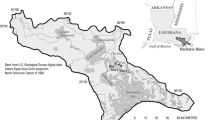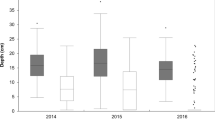Abstract
Bottomland hardwood (BLH) forests have important biogeochemical functions and it is well known that certain structural components, including pulsed hydrology, hydric soils, and hydrophytic vegetation, enhance these functions. It is unclear, however, how functions of restored BLH wetlands compare to mature, undisturbed wetlands. We measured a suite of structural and functional attributes in replicated natural BLH wetlands (NAT), restored BLH wetlands with hydrology re-established (RWH), and restored BLH wetlands without hydrology re-established (RWOH) in this study. Trees were replanted in all restored wetlands at least four years prior to the study and those wetlands with hydrology re-established had flashboard risers placed in drainage ditches to allow seasonal surface flooding. Vegetation, soils, and selected biogeochemical functions were characterized at each site. There was a marked difference in woody vegetation among the wetlands that was due primarily to site age. There was also a difference in herbaceous vegetation among the restored sites that may have been related to differences in age or hydrology. Water table fluctuations of the RWH wetlands were comparable to those of the NAT wetlands. Thus, placing flashboard risers in existing drainage ditches, along with proper management, can produce a hydroperiod that is similar to that of a relatively undisturbed BLH. Average length of saturation within the upper 15 cm of soils was 37, 104, and 97 days for RWOH, RWH, and NAT, respectively. Soil moisture, denitrification potential, and soluble organic carbon concentrations differed among wetland sites, but soil carbon and nitrogen concentrations, heterotrophic microbial activity, and readily mineralizable carbon concentrations did not. Significant linear relationships were also found between soil moisture and heterotrophic microbial activity, readily mineralizable carbon, and soluble organic carbon. In addition, sedimentation rates were higher in NAT and RWH wetlands than in RWOH sites. Results of this study suggest that reconnection of bottomland hardwood wetlands to their surrounding watershed through the restoration of surface hydrology is necessary to restore wetland functions important to nutrient and sediment removal.
Similar content being viewed by others
Literature Cited
Ambus, P. 1993. Control of denitrification enzyme activity in a streamside soil. Federation of European Microbiological Societies Microbiology Ecology 102: 225–34.
Boyer, J. N. and P. M. Groffman. 1996. Bioavailability of water extractable organic carbon fractions in forest and agricultural soil profiles. Soil Biology and Biochemistry 28: 783–90.
Brettar, I., J. M. Sanchez-Perez, and M. Tremoleres. 2002. Nitrate elimination by denitrification in hardwood forest soils of the Upper Rhine floodplain — correlation with redox potential and organic matter. Hydrobiologia 469: 11–12.
Bridgham, S. D., J. P. Megonigal, J. K. Keller, N. B. Bliss, and C. Trettin. 2006. The carbon balance of North American wetlands. Wetlands 26: 889–916.
Bruland, G. L. and C. J. Richardson. 2005. Hydrologic, edaphic, and vegetative responses to microtopographic reestablishment in a restored wetland. Restoration Ecology 13: 515–23.
Cahoon, D. R. and R. E. Turner. 1989. Accretion and canal impacts in a rapidly subsiding wetland II: feldspar marker horizon technique. Estuaries 12: 260–68.
Cavalcanti, G. C. and B. G. Lockaby. 2006. Effects of sediment deposition on aboveground net primary productivity, vegetation composition, and structure in riparian forests. Wetlands 26: 400–09.
Cey, E. E., D. L. Rudolph, R. Aravena, and G. Parkin. 1999. Role of the riparian zone in controlling the distribution and fate of agricultural nitrogen near a small stream in southern Ontario. Journal of Contaminant Hydrology 37: 45–67.
Clairain, E. J., Jr. and B. A. Kleiss. 1989. Functions and values of bottomland hardwood forests along the Cache River, Arkansas: Implications for management. In D. Hook and R. Lea (eds.) The Forested Wetlands of the Southeastern United States. Gen. Tech. Report SE-50. US Department of Agriculture, Forest Service, Southeastern Forest Experiment Station.
Clewell, A. F. and R. Lea. 1989. Creation and restoration of forested wetland vegetation in the southeastern United States. p. 199–238. In J. A. Kusler and M. E. Kentula (eds.) Wetland Creation and Restoration: The Status of the Science. U.S. Environmental Protection Agency, Environmental Research Laboratory, Corvallis, OR, USA. Vol. 1. U.S. EPA/7600/3089/038.
Corstanje, R. and K. R. Reddy. 2004. Response of biogeochemical indicators to a drawdown and subsequent re-flood. Journal of Environmental Quality 33: 2357–66.
D’Angelo, E. M., A. D. Karathanasis, E. J. Sparks, S. A. Ritchey, and S. A. Wehr-McChesney. 2005. Soil carbon and microbial communities at mitigated and late successional bottomland forest wetlands. Wetlands 25: 162–75.
Davidson, E. A., L. F. Galloway, and M. K. Strand. 1987. Assessing available carbon: comparison of techniques across selected forest soils. Communications in Soil Science and Plant Analysis 18: 45–64.
Drury, C. F., T. O. Oloya, D. J. McKenney, E. G. Gregorich, C. S. Tan, and C. L. vanLuyk. 1998. Long-term effects of fertilization and rotation on denitrification and soil carbon. Soil Science Society of America Journal 62: 1572–79.
Faulkner, S. P. and W. H. Patrick, Jr. 1992. Redox processes and diagnostic wetland indicators in bottomland hardwood forests. Soil Science Society of America Journal 56: 856–65.
Faulkner, S. P., W. H. Patrick, Jr, and R. P. Gambrell. 1989. Field techniques for measured wetland soil parameters. Journal of Environmental Quality 53: 883–90.
Giese, L. A. B., W. M. Aust, R. K. Kolka, and C. C. Tretting. 2003. Biomass and carbon pools of disturbed riparian forests. Forest Ecology and Management 180: 493–508.
Groffman, P. M., G. C. Hanson, E. Kiviat, and G. Stevens. 1996. Variation in microbial biomass and activity in four different wetland types. Soil Science Society of America Journal 60: 622–29.
Groffman, P. M. and J. M. Tiedje. 1989. Denitrification in north temperate forest soils: relationships between denitrification and environmental factors at the landscape scale. Soil Biology and Biochemistry 21: 621–26.
Hanson, G. C., P. M. Groffman, and A. J. Gold. 1994. Denitrification in riparian wetlands receiving high and low groundwater nitrate inputs. Journal of Environmental Quality 23: 917–22.
Haynes, R. J. and L. Moore. 1988. Reestablishment of bottomland hardwoods within national wildlife refuges in the Southeast. p. 95–103. In J. Zelazny and J. S. Feierabend (eds.) Increasing Our Wetland Resources. National Wildlife Federation, Washington, DC, USA.
Hill, A. R. 1996. Nitrate removal in stream riparian zones. Journal of Environmental Quality 25: 743–55.
Hogan, D. M., T. E. Jordan, and M. R. Walbridge. 2004. Phosphorus retention and soil organic carbon in restored and natural freshwater wetlands. Wetlands 24: 573–85.
Holland, L. J. and L. B. Phelps. 1986. Topsoil compaction during reclamation: field studies. p. 55–62. In D. H. Graves and R. W. De Yore (eds.) Proceedings of National Symposium on Mining, Hydrology, Sedimentology, and Reclamation. University of Kentucky, Lexington, KY, USA.
Hunter, R. G. and S. P. Faulkner. 2001. Comparison of denitrification potential between restored and natural bottomland hardwood wetlands. Soil Science Society of America Journal 65: 1865–72.
Kaiser, K. and W. Zech. 1996. Nitrate, sulfate, and biphosphate retention in acid forest soils affected by natural dissolved organic carbon. Journal of Environmental Quality 25: 1325–31.
Keddy, P. A. 2000. Wetland Ecology: Principles and Conservation. Cambridge University Press, Cambridge, UK.
Kellison, R. C. and M. J. Young. 1997. The bottomland hardwood forests of the southern United States. Forest Ecology and Management 90: 101–15.
Lockaby, B. G., R. Governo, E. Schilling, G. Cavalcanti, and C. Hartsfield. 2005. Effects of sedimentation on soil nutrient dynamics in riparian forests. Journal of Environmental Quality 34: 390–96.
Lockaby, G. and J. A. Stanturf. 2000. Potential effects of restoration on biogeochemical functions on bottomland hardwood ecosystems. p. 116–19. In M. M. Holland, M. L. Warren, and J. A. Stanturf (eds.) Proceedings of a Conference on Sustainability of Wetlands and Water Resources, May 23–25, Oxford, MS, USA.
Lockaby, G. and M. R. Walbridge. 1998. Biogeochemistry. p. 149–72. In M. G. Messina and W. H. Conner (eds.) Southern Forested Wetlands: Ecology and Management. Lewis Publishers, Boca Raton, FL, USA.
Lowrance, R. 1992. Groundwater nitrate and denitrification in a coastal plain riparian forest. Journal of Environmental Quality 21: 401–05.
Maag, M., M. Malinovsky, and S. M. Nielson. 1997. Kinetics and temperature dependence of potential denitrification in riparian soils. Journal of Environmental Quality 26: 215–23.
McKee, K. L. and P. L. Faulkner. 2000. Restoration of biogeochemical function in mangrove forests. Restoration Ecology 8: 247–59.
McLean, E. O. 1965. Aluminum. p. 978–98. In C. A. Black, D. D. Evans, J. L. White, L. E. Ensminger, F. E. Clark, and R. C. Dinauer (eds.) Methods of Soil Analyses, Part 2: Chemical and Microbiological Properties. Soil Science Society of America, Madison, WI, USA.
Merrill, A. G. and D. R. Zak. 1992. Factors controlling denitrification rates in upland and swamp forests. Canadian Journal of Forest Research 22: 1597–1604.
Middleton, B. A. 2002. The flood pulse concept in wetland restoration. p. 1–10. In B. Middleton (ed.) Flood Pulsing in Wetlands. John Wiley & Sons, Inc., New York, NY, USA.
Patrick, W. H. 1958. Modification of method of soil particle size analysis. Soil Science Society of America Proceedings 22: 366–67.
Patrick, W. H., Jr., R. P. Gambrell, and S. P. Faulkner. 1996. Redox measurements in soil. p. 1255–73. In D. L. Sparks (ed.) Methods of Soil Analysis, Part 3: Chemical Methods. Soil Science Society of America, Madison, WI, USA.
Reed, J. P., H. R. Kruegar, and F. R. Hall. 1989. Fluorescein diacetate hydrolysis for determination of accelerated degradation of thiocarbamate herbicides. Bulletin of Environmental Contamination and Toxicology 43: 929–34.
SAS Institute Inc. 1994. SAS User’s Guide: Statistics. Version 6 edition. SAS Institute Inc., Cary, NC, USA.
Schlesinger, W. H. 1991. Biogeochemistry: An Analysis of Global Change. Academic Press, San Diego, CA, USA.
Tiedje, J. M. 1982. Denitrification. p. 1011–26. In A. L. Page (ed.) Methods of Soil Analysis, Part 2: Microbiological and Biochemical Properties. Soil Science Society of America, Madison, WI, USA.
USDA-NRCS. 1998. Wetlands reserve program fact sheet — 1996 Farm Bill conservation provisions. OPA/FB96OPA.
USDA-NRCS. 2005. Wetland reserve program fact sheet. http:// www.nrcs.usda.gov/programs/wrp. Accessed May 9, 2005.
Verchot, L. V., E. C. Franklin, and J. W. Gilliam. 1998. Effects of agricultural runoff dispersion on nitrate reduction in forested filter zone soils. Soil Science Society of America Journal 62: 1719–24.
Walbridge, M. R. 1993. Functions and values of forested wetlands in the southern United States. Journal of Forestry 91: 15–19.
Author information
Authors and Affiliations
Rights and permissions
About this article
Cite this article
Hunter, R.G., Faulkner, S.P. & Gibson, K.A. The importance of hydrology in restoration of bottomland hardwood wetland functions. Wetlands 28, 605–615 (2008). https://doi.org/10.1672/07-139.1
Received:
Accepted:
Issue Date:
DOI: https://doi.org/10.1672/07-139.1




